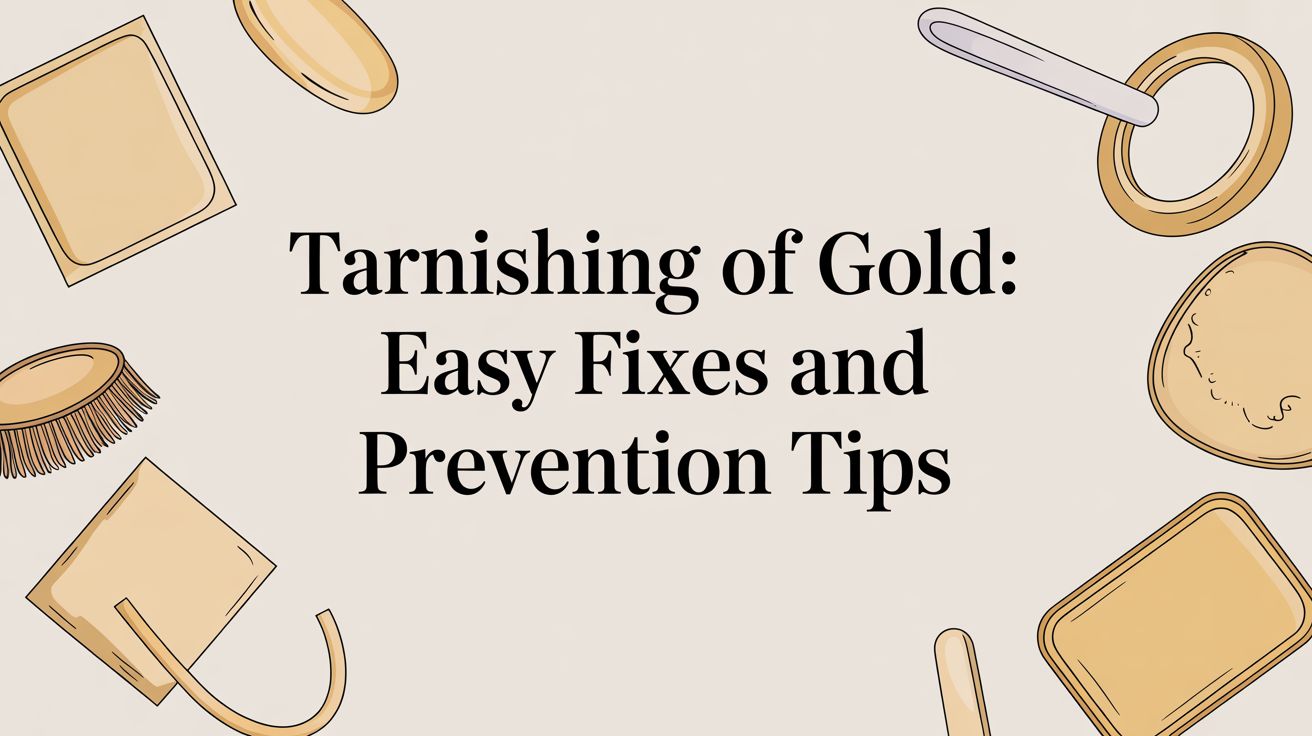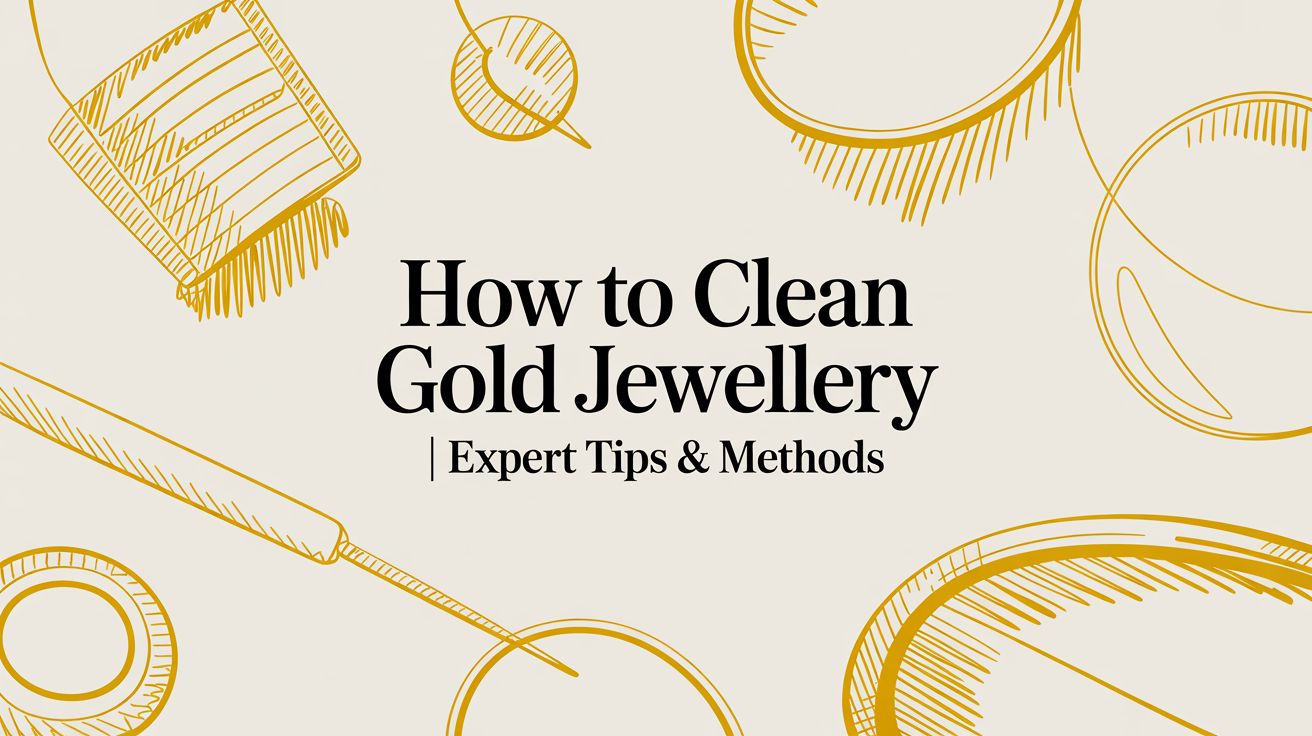It’s one of the biggest myths in jewellery: that gold is untouchable, immune to any kind of corrosion or discolouring. The surprising truth? Pure gold does not tarnish. The dullness or dark spots you see are caused by the other metals—like copper, silver, and nickel—that are mixed with gold to make it strong enough for jewellery.
The Surprising Truth About Why Gold Tarnishes
When you see a piece of gold jewellery losing its shine, it’s not the gold itself that’s changing. Pure, 24-karat gold is what’s known as a noble metal, meaning it's incredibly non-reactive. It won’t rust, corrode, or tarnish when exposed to air or moisture. Think of it as a perfectly stable, unchangeable element.
The problem is, pure gold is far too soft for everyday wear. A ring made from 24k gold would bend and scratch with the slightest pressure. To solve this, jewellers create alloys by mixing pure gold with other, stronger metals. And that’s where the potential for tarnish begins.
The Role of Alloy Metals
The metals used to strengthen gold are the real culprits behind any discolouration. These alloys give us the different colours and karats we love, but they simply aren’t as chemically stable as gold itself.
Common alloy metals include:
- Copper: Often used to create rose gold, copper is highly reactive and can oxidise, leading to dark or even greenish spots.
- Silver: A key part of yellow and white gold, silver can react with sulphur in the air, creating a dark layer of tarnish.
- Nickel: Frequently used in white gold alloys, nickel can also react with chemicals and cause discolouration.
- Zinc: Another metal added for durability, which can contribute to the overall potential for tarnishing.
The discolouration on your gold jewellery is a direct result of these alloy metals reacting with their environment. The pure gold content remains untouched and as brilliant as ever underneath.
Essentially, the more non-gold metal in a piece, the more likely it is to tarnish. A 9-karat gold ring, which contains only 37.5% pure gold, has a much higher risk of showing tarnish than an 18-karat ring, which is 75% pure gold.
Think of it like a recipe: the alloy metals are ingredients mixed in to get the final result. Some of those ingredients can spoil when left exposed, even if the main ingredient cannot. This is the key to understanding why looking after your gold starts with knowing its purity.
How Gold Purity Affects Tarnish Risk
The secret to why some gold tarnishes and some doesn't comes down to one simple thing: purity.
Pure, 24-karat gold is chemically inert. On its own, it simply won’t tarnish. But almost all gold jewellery is actually an alloy—a blend of pure gold with other metals to give it strength and colour. It's the type and amount of these other metals that determine how likely your piece is to discolour over time.
Think of it this way: pure gold is like still water—stable and unchanging. When you mix in other ingredients (the alloy metals) to create different karats and colours, you're introducing elements that can react with the world around them. The more of these additives you have, the more likely the mixture is to change. That’s exactly what’s happening with your gold jewellery.
This infographic shows it perfectly—the tarnish comes from the alloy metals, not the gold itself.
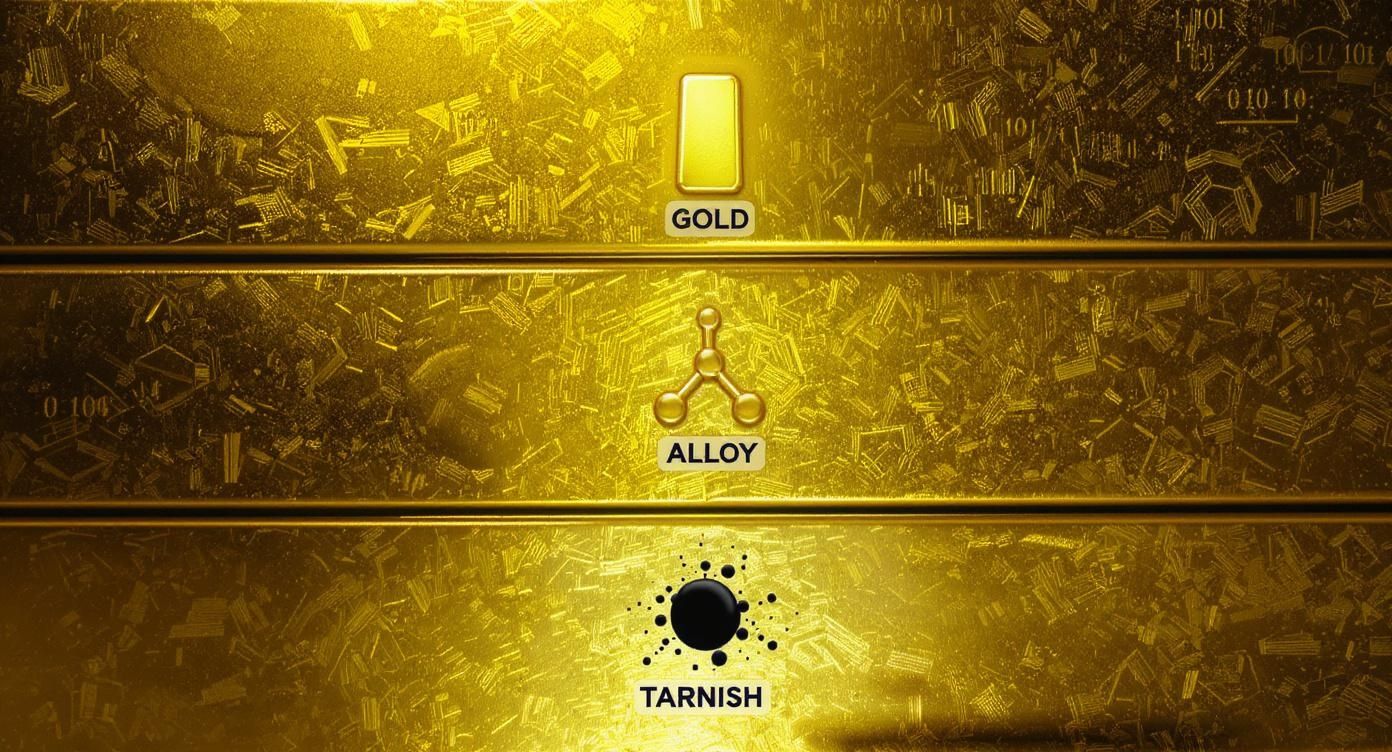
It’s not a flaw in the gold, but a natural chemical reaction happening with the less stable metals mixed into it.
Understanding Karats and Alloys in the UK
Here in the UK, you’ll mostly find gold jewellery in 9k, 14k, 18k, and 22k varieties. Each karat tells you the ratio of pure gold to other metals, measured in parts out of 24.
- 9k Gold: This is 37.5% pure gold mixed with 62.5% alloy metals. That high percentage of other metals makes it the most likely to tarnish.
- 14k Gold: Contains 58.3% pure gold. It strikes a good balance between durability and tarnish resistance but can still discolour with exposure.
- 18k Gold: At 75% pure gold, it's a favourite for fine jewellery and is significantly more resistant to tarnish than the lower karats.
- 22k Gold: With 91.67% pure gold, it has fantastic resistance to tarnishing. The trade-off is that it’s much softer and more prone to scratching.
The maths is simple. A 9k gold ring has almost double the amount of reactive alloy metals as an 18k one, making it far more likely to show tarnish from everyday wear.
How Different Alloy Metals Cause Tarnish
The type of tarnish—whether it's black, dark brown, or even greenish—depends entirely on which metals are in the alloy.
For instance, rose gold gets its gorgeous warm colour from a high dose of copper. But copper is highly reactive and oxidises easily, which can leave dark or greenish spots on the surface.
White gold, on the other hand, often contains silver, nickel, or palladium. Silver is notorious for reacting with sulphur in the air, creating a dark film of silver sulphide. This is why you might see a dull, darkish tinge appear on white gold pieces as their protective rhodium plating wears away.
Your gold’s colour and karat give you a clear roadmap to its tarnish risk. A 9k rose gold piece, full of copper, is at the highest risk, while a 22k yellow gold item is one of your safest bets against discolouration.
This balancing act between durability and purity isn’t just for jewellery. Think about the UK Sovereign coins produced by The Royal Mint. They use 22-karat gold—91.67% gold mixed with copper and silver. This was a deliberate choice to make the coins tough enough to survive in circulation, something pure 24k gold could never do. They prioritised durability over total tarnish resistance, a decision you can learn more about from the experts at Physical Gold.
Gold Karat vs. Tarnish Resistance
To lay it all out, this table breaks down the common gold karats you'll find in the UK, showing their composition and how it affects their risk of tarnishing.
| Karat Value | Pure Gold Content | Common Alloy Metals (UK) | Relative Tarnish Risk |
|---|---|---|---|
| 9k | 37.5% | Copper, Silver, Zinc | High |
| 14k | 58.3% | Copper, Silver, Nickel | Moderate |
| 18k | 75% | Copper, Silver | Low |
| 22k | 91.67% | Copper, Silver | Very Low |
Ultimately, choosing a piece of gold means understanding this trade-off. While lower-karat gold is more affordable and durable, it comes with the certainty of chemical reactions. It just needs a little more care to keep that inevitable tarnish at bay.
Everyday Things That Tarnish Your Gold
Right, so we've covered the science behind gold alloys. Now let's get practical and look at the real-world culprits that are silently dulling the sparkle on your favourite pieces. These are the everyday chemicals and environmental triggers you probably don't even think about.
Many of these are just part of our daily lives, from the lotions we put on our skin to the very air we breathe. Knowing what they are is the first step to protecting your jewellery.
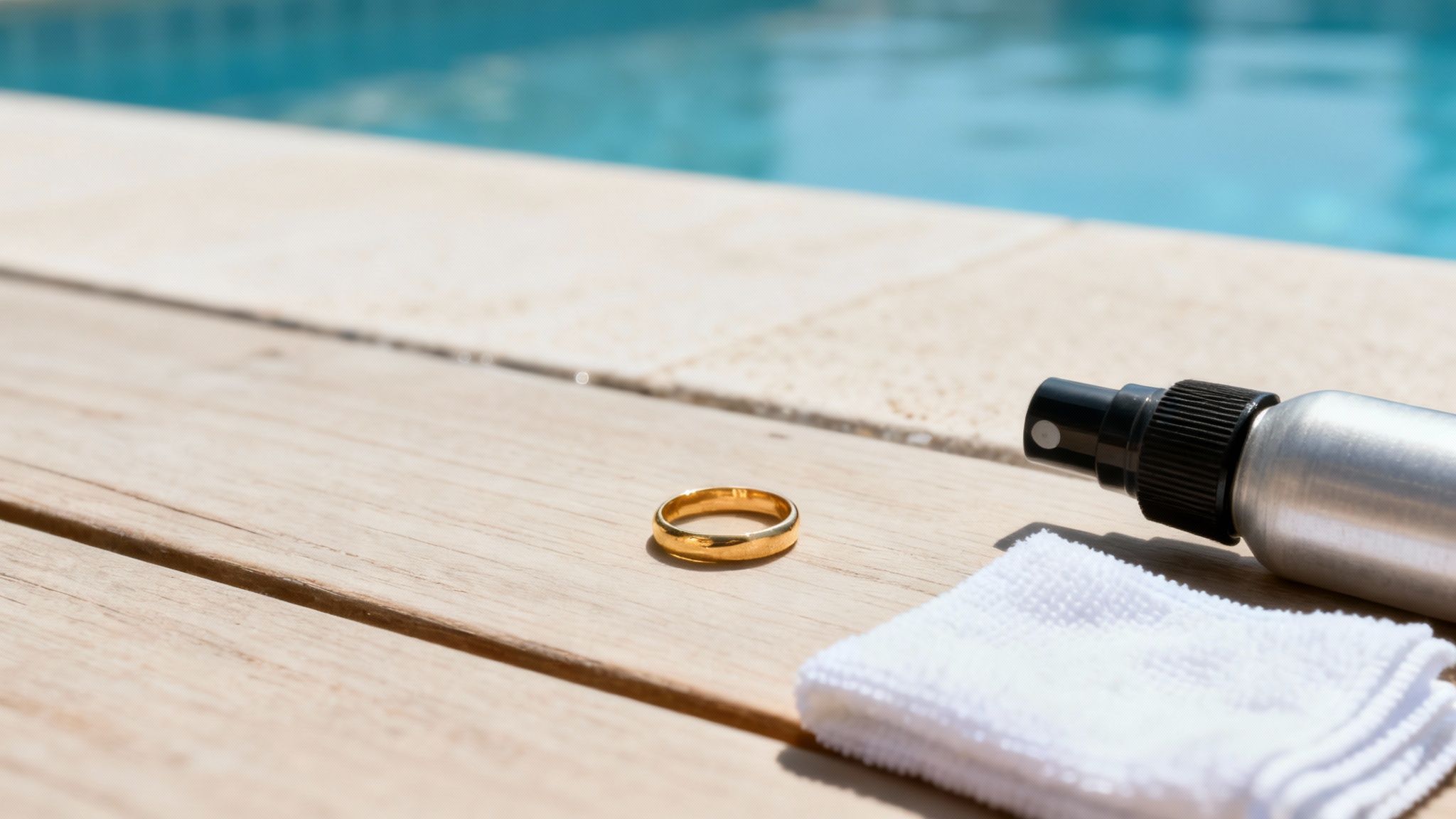
Chemical Culprits in Your Home
You'd be surprised how many things in your home can speed up the tarnishing process on the metals mixed into your gold. Most of them are so common you wouldn't give them a second thought.
Here are a few of the main offenders:
- Sulphur Compounds: Found in everything from onions and eggs to polluted city air, sulphur is a major cause of tarnish, especially for any alloys containing silver.
- Chlorine: This is a harsh one. It’s in swimming pools, hot tubs, and loads of household cleaners, and it can permanently damage and discolour gold alloys. It's one of the worst things for your jewellery.
- Acids: Milder substances like vinegar, fruit juice, and even some harsh cleaning products can slowly eat away at the less durable metals in your gold alloy.
Just think about your morning routine. You might apply lotion, use hairspray, and add a spritz of perfume. Every single one of these products contains chemicals that can build up a film on your jewellery, trapping dirt and accelerating corrosion on the copper and silver within.
The golden rule for jewellery care is simple: "Last on, first off." Your gold pieces should be the last thing you put on after all your cosmetics are applied, and the first thing you take off before you get undressed.
Your Body and the Environment
It’s not just chemicals from a bottle you need to worry about. Your own body chemistry and your immediate surroundings play a huge role.
The natural oils and sweat on your skin can kick off a chemical reaction, particularly if your body's pH is on the more acidic side. This explains why a ring you wear all day, every day might tarnish faster than a necklace you only wear now and then. That constant contact creates the perfect little environment for a reaction to happen.
Humidity is another big factor. Moisture in the air is like an accelerator for the oxidation of metals like copper. Living in the UK, with its damp, temperate climate, this is a particular challenge. If your gold isn't stored properly, the constant dampness puts it at a much higher risk of discolouring.
This problem is so real that even the Bank of England uses strict climate controls to shield the UK's gold reserves from humidity and air pollution. For a personal collection, especially if you live near the coast where salty air is a factor, the risk is even greater. You can actually learn more about how the UK's gold reserves are protected on Atkinsons Bullion's blog.
Ultimately, protecting your gold is about creating a barrier between it and the outside world. It comes down to mindful habits, like taking your jewellery off before certain activities and storing it correctly to shield it from these environmental attacks.
How to Prevent Gold From Tarnishing
Knowing the science behind why gold tarnishes is one thing, but actively protecting your treasured pieces is where true care begins. It's always far easier to prevent discolouration than to reverse it later on. A few simple, mindful habits are all it takes to create a powerful shield against the everyday elements that dull your jewellery’s shine.
The goal is to minimise your gold’s contact with the chemical and environmental triggers that cause its alloy metals to react. Think of it as creating a safe zone for your jewellery, both on your body and when you take it off. A little conscious effort goes a long way in preserving that brilliant lustre for years to come.
Smart Storage Solutions
Proper storage is your first line of defence. When you’re not wearing your gold, its environment plays a huge role in its condition. Simply leaving a piece on a bedside table exposes it to humidity, dust, and airborne pollutants that accelerate corrosion.
To keep your pieces safe and sound, just follow these simple guidelines:
- Keep It Dry: Humidity is the biggest enemy here. Store your jewellery in a cool, dry place, far from the steam of a bathroom or a damp windowsill. A dedicated jewellery box with a soft, protective lining is perfect.
- Store Pieces Separately: When jewellery pieces rub against each other, they can cause microscopic scratches. These not only dull the surface but also make it more susceptible to tarnish. Use individual soft pouches or a box with separate compartments to stop them from touching.
- Use Anti-Tarnish Strips: For added protection, especially for valuable or sentimental items, slip a few anti-tarnish strips or cloths into your storage box. They work by absorbing the airborne sulphides and other pollutants that cause discolouration.
Daily Wear and Care Habits
How you wear your gold every day makes a massive difference to its longevity. Your daily routine is filled with potential tarnish triggers, from the cosmetics you use to the chores you do.
The most important rule to remember is “last on, first off.” Your jewellery should be the final touch after you’ve applied all your lotions, perfumes, and hairsprays. At the end of the day, it should be the very first thing you take off.
By putting your jewellery on last, you create a barrier between the metal alloys and the potentially corrosive chemicals in your cosmetics. This single habit can dramatically reduce residue buildup and slow the tarnishing of gold.
It’s also crucial to remove your gold before any activity involving moisture or harsh chemicals. That means taking it off before showering, swimming in chlorinated pools, cleaning with household products, or even exercising, as sweat can be acidic and speed up reactions.
Simple Maintenance Routines
A consistent, gentle cleaning routine is vital for stopping grime and tarnish from taking hold. You don’t need aggressive chemicals; a simple wipe-down can make all the difference.
After each wear, gently buff your jewellery with a soft, lint-free cloth—a microfibre or specialised jewellery cloth is ideal. This quick action removes skin oils, makeup residue, and any moisture that’s built up through the day. It prevents these substances from sitting on the surface and reacting with the alloys overnight. For a slightly deeper at-home clean, you can find more detailed tips in our guide on how to polish gold jewellery.
By integrating these smart storage, daily wear, and maintenance habits into your routine, you actively fight against the tarnishing of gold. These small, consistent efforts are the secret to keeping your pieces as radiant and beautiful as the day you first wore them.
Safely Cleaning Tarnished Gold at Home
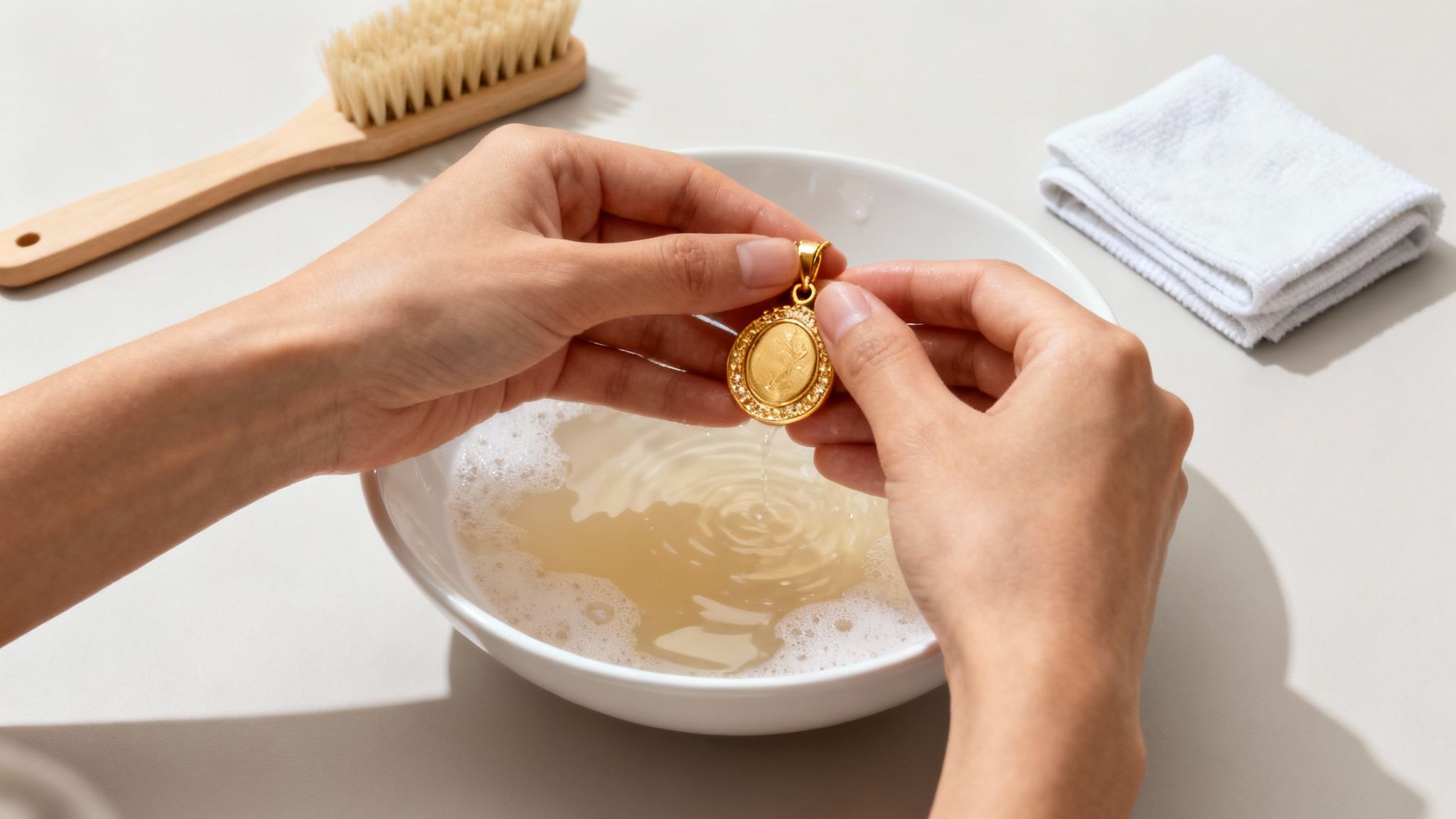
When you spot that first hint of discolouration on a treasured piece, it’s tempting to reach for a powerful, quick-fix cleaner. But when it comes to gold, an aggressive approach is the fastest way to cause permanent damage.
A gentle, patient hand is always the safest and most effective way to restore your jewellery’s brilliance without harming its delicate surface. The good news? For light to moderate tarnish, you probably have everything you need in your kitchen already.
This simple method is all about lifting away the surface corrosion and grime, not scrubbing it off by force.
The Gentle Soap and Water Method
This is the time-tested technique professional jewellers turn to first, and for good reason: it’s incredibly effective yet perfectly safe for most gold jewellery. It works by gently breaking down the oils and sulphides that cause tarnish, allowing them to be simply washed away.
What You’ll Need:
- A small bowl of warm water (not hot, as high heat can damage some gemstones).
- A few drops of mild, phosphate-free washing-up liquid.
- A very soft-bristled brush, like a baby’s toothbrush or a dedicated jewellery brush.
- A soft, lint-free cloth for drying.
That’s it. This simple setup is all you need to safely tackle the early stages of tarnish.
Step-by-Step Cleaning Process
Follow these steps carefully, and remember that patience is key. Resist the urge to scrub.
- Create the Cleaning Solution: Fill your bowl with warm water, add a small amount of washing-up liquid, and give it a gentle swirl to create a sudsy bath.
- Soak Your Jewellery: Place your gold piece in the solution and let it sit for 15-20 minutes. This is the most important step, as it softens and loosens the grime, making it easy to remove without friction.
- Gently Brush the Surface: After soaking, take your soft-bristled brush and gently clean the item. Use soft, circular motions, paying extra attention to any crevices or areas around stone settings where dirt loves to hide.
- Rinse Thoroughly: Hold the piece under a gentle stream of lukewarm running water. Make sure every trace of soap is gone, as any residue left behind can create a dull film.
- Dry and Buff: Carefully pat the jewellery dry with your soft, lint-free cloth. Once it's completely dry, use a clean part of the cloth to give it a final, gentle buff to bring out its natural lustre.
Remember, the goal is to lift the tarnish away, not scrub it into submission. This method prioritises the long-term health of your jewellery over a quick, but potentially damaging, fix.
For a more detailed look at jewellery care, our guide offers more tips on how to clean gold jewellery at home.
What to Avoid When Cleaning Gold
Knowing what not to do is just as critical as knowing what to do. The wrong tools or chemicals can cause irreversible damage, from tiny scratches that dull the surface to serious chemical reactions.
NEVER use these on your gold:
- Toothpaste: It’s full of mild abrasives that will cover your gold in micro-scratches, permanently dulling its shine.
- Baking Soda: Often touted in DIY guides, its crystalline structure is abrasive and not suitable for fine jewellery.
- Harsh Chemicals: Bleach, chlorine, and ammonia are extremely corrosive to the other metals in your gold alloy and can cause lasting damage.
- Abrasive Brushes or Cloths: Anything other than a super-soft brush or a lint-free cloth (so no paper towels or rough fabrics) will scratch the metal.
By sticking to the simple soap-and-water method and steering clear of these harmful agents, you can confidently restore your gold’s beauty while ensuring it stays that way for years to come.
When to Call a Professional Jeweller
The gentle soap and water method is brilliant for routine upkeep, but some jobs are best left to the experts. Knowing the limits of at-home cleaning is crucial for protecting your most valuable pieces—especially when you’re dealing with more than just light tarnish.
Pushing a DIY fix too far can turn a simple restoration into a costly repair. Recognising when to step back is a key part of responsible jewellery ownership. At a workshop like Opulence Jewellery Services, we have the specialist tools and expertise to handle complex issues safely, bringing your treasured items back to their former glory without the risk.
Signs You Need an Expert
Some types of tarnish, and certain kinds of jewellery, just aren't suited for at-home cleaning. If you spot any of the following, it’s a clear sign to seek professional help.
- Heavy or Stubborn Tarnish: If the discolouration is dark, widespread, or won't budge after a gentle clean, it’s likely more than a surface film. Forceful scrubbing at this point will only cause scratches.
- Antique and Heirloom Pieces: Older jewellery can be incredibly fragile. The alloys might be unknown and could react badly to cleaning solutions, while delicate filigree or old settings can be easily bent or broken.
- Intricate Designs: Pieces with complex patterns, engravings, or tiny crevices trap grime deep down where a soft brush simply can’t reach.
Why Professional Techniques Are Superior
Jewellers use methods that are far more effective and controlled than anything you can do at home. These techniques restore brilliance while preserving the integrity of the metal and any gemstones.
Ultrasonic Cleaning: Professionals use ultrasonic cleaners that send high-frequency sound waves through a cleaning solution. This creates millions of microscopic bubbles that gently but powerfully dislodge dirt from every tiny nook and cranny—a level of clean that's impossible to achieve by hand.
A professional jeweller doesn’t just clean your piece; they inspect it under magnification. They can spot issues like a loose prong or a weakening clasp before it becomes a major problem, saving you from potential loss or damage.
Expert Polishing and Finishing: For significant tarnish and surface scratches, a jeweller uses professional-grade polishing machines with specialised compounds. This process carefully removes a microscopic layer of metal to reveal the fresh, unblemished gold beneath, restoring that flawless, mirror-like shine. It’s a finish you can never replicate with a polishing cloth. For white gold, a professional can also reapply a fresh layer of rhodium—you can learn more about this in our article explaining how long rhodium plating lasts.
Protecting Pieces with Delicate Gemstones
Perhaps the most critical reason to call a professional is when your tarnished gold jewellery features certain gemstones. Many popular stones are soft, porous, or treated, making them highly vulnerable to damage from water and chemicals.
- Porous Stones: Pearls, opals, turquoise, and coral can absorb liquids, leading to permanent discolouration or cracking.
- Soft Gemstones: Amber, lapis lazuli, and malachite can be easily scratched by even the softest brush.
- Treated Stones: Emeralds are often fracture-filled, and ultrasonic cleaners can damage or remove these enhancements.
Trusting a professional with these pieces is non-negotiable. We have the specific knowledge to protect each unique gemstone while effectively treating the tarnishing of gold that surrounds it, ensuring your entire piece is restored safely and beautifully.
Your Questions Answered
Even when you know the science, it's natural to have a few specific questions about gold tarnish. Here are straightforward answers to the queries we hear most often in our workshop, clearing up any lingering doubts about keeping your pieces pristine.
Does 24k Pure Gold Ever Tarnish?
No, pure 24-karat gold never tarnishes. It’s what’s known as a ‘noble metal,’ meaning it’s chemically inert and simply doesn’t react with oxygen or other elements that cause corrosion.
Any discolouration you see on a gold item is always down to the other metals—like copper, silver, or zinc—that have been mixed in to make it stronger. The rule is simple: the lower the karat, the more of these reactive metals are present, and the higher the risk of tarnish. An 18k piece has a far lower chance of discolouring than a 9k piece for this very reason.
Is Tarnish Permanent Damage to My Jewellery?
In almost all cases, no—tarnish is a surface-level issue, not permanent damage. Think of it as a thin film of corrosion that has formed on the alloy metals, which can nearly always be removed with the gentle cleaning methods we covered earlier.
The real risk comes from using the wrong cleaning techniques. Scrubbing with harsh abrasives like toothpaste or baking soda will create micro-scratches, permanently dulling the gold’s finish. Always stick to gentle, approved methods to protect your item’s integrity.
Tarnish is a treatable condition, not a terminal one. The real danger isn’t the discolouration itself, but using improper methods to remove it.
Why Does My Gold Ring Turn My Skin Black or Green?
This is a very common and completely harmless reaction. The mark on your skin is caused when the alloy metals in your ring—usually copper—react with the natural acids in your sweat or with chemicals from lotions, soaps, and perfumes. That dark residue is just a type of metallic salt created by the reaction.
To minimise this, keep both your ring and your skin clean and dry. Taking your ring off before applying lotion or washing your hands makes a huge difference.
How Often Should I Get My Gold Professionally Cleaned?
For pieces you wear daily, like an engagement ring or a favourite necklace, a professional clean once or twice a year is a great routine. A jeweller can safely remove deep-set grime and, just as importantly, will inspect the piece for issues like loose stones or worn prongs.
For items kept in storage, like gold coins or heirlooms, professional help is only needed if you notice significant tarnish developing.
Keeping your treasured pieces looking their best takes a mix of good habits and expert attention when required. For a professional clean, polish, or repair that respects the integrity of your jewellery, visit Opulence Jewellery Services at our Hatton Garden workshop. Restore your gold's original brilliance with craftsmen you can trust. Learn more about our services.
